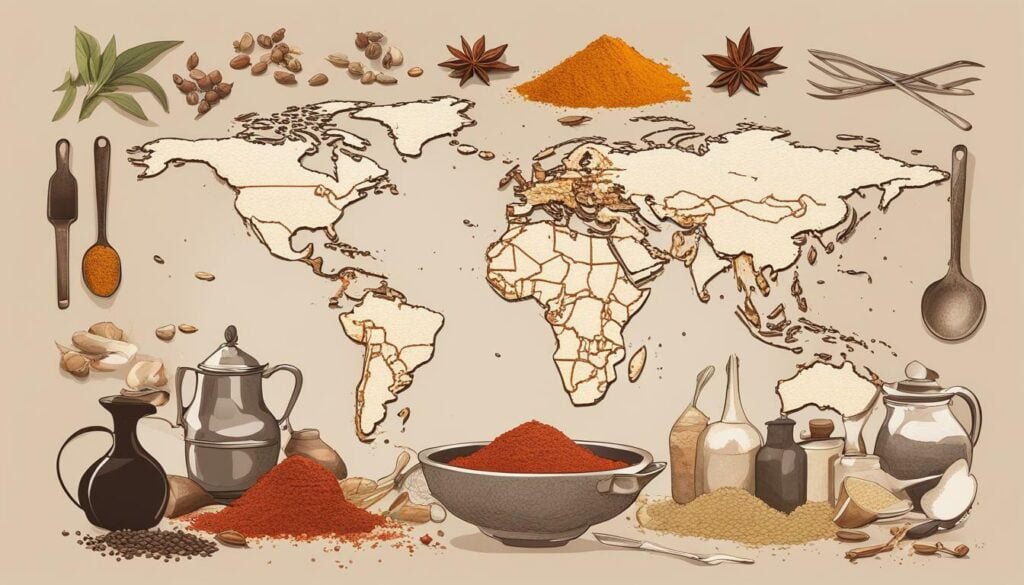At a time when mindfulness and conscious living have become integral to our daily routines, what better way to explore the world than through the lens of global cuisine? With home cooking on the rise, we can embark on culinary adventures from the comfort of our own kitchens, experiencing new flavors, ingredients, and cultural traditions along the way. Join us as we delve into the world of mindful living and the power of global cuisines to nourish both the body and mind.
Key Takeaways:
- Mindful living can be incorporated into everyday life through the exploration of global cuisines at home.
- By practicing present moment awareness while cooking and eating, we can promote mindful living and holistic well-being.
- Global cuisines offer a diverse array of flavors, ingredients, and cultural traditions to explore and enjoy.
- Home cooking provides an opportunity for culinary exploration and self-discovery, promoting personal growth and creativity.
Mindful Living: A Path to Holistic Well-being
At the core of mindful living is the practice of being present and fully engaged in our daily lives. By incorporating mindfulness into our routines, we can cultivate healthy habits, reduce stress, and improve overall well-being.
One of the key aspects of mindful living is developing a conscious lifestyle that promotes self-awareness, gratitude, and compassion. This can involve a range of mindfulness practices, including meditation, yoga, or simply taking a few moments each day to breathe deeply and focus on the present moment.
When it comes to healthy habits, mindful living emphasizes the importance of nourishing our bodies with wholesome, nutritious foods. By making conscious choices about the foods we eat, we can improve our physical health and mental clarity, and reduce the risk of chronic illness and disease.
Another important aspect of mindful living is stress reduction. By practicing mindfulness techniques such as deep breathing, visualization, and positive self-talk, we can cultivate a greater sense of calm and inner peace, even in the midst of challenging situations.

Ultimately, the goal of mindful living is to create a more balanced, fulfilling life that supports our overall well-being. By embracing conscious living and healthy habits, we can cultivate a greater sense of connection to ourselves and the world around us, and live more fully in each moment.
The Power of Food: Nourishing Body and Mind
At the heart of mindful living is the notion that what we eat can have a significant impact on our overall well-being. In the pursuit of a conscious lifestyle, it is essential to consider the nutritional value of the food we consume, as well as the manner in which we eat it. This is where the concept of mindful eating comes into play.
Global cuisines offer a wealth of diverse and flavorful options that can provide both nutritional benefits and sensory satisfaction. By exploring different cuisines, we can expand our palates and enrich our understanding of the cultures from which they originate.
Mindful eating involves paying close attention to the sensory experience of consuming food, including the colors, smells, textures, and flavors. It also involves listening to our bodies and being mindful of our hunger and fullness cues. By doing so, we can develop a healthier relationship with food and nourish our bodies in a way that promotes overall well-being.
When preparing and enjoying meals, it is also important to incorporate self-care routines. This can include setting aside dedicated time for meal preparation, using fresh ingredients, and taking breaks to practice mindfulness and deep breathing exercises.
| Global Cuisines | Mindful Eating Benefits |
|---|---|
| Japanese | The Japanese diet is rich in fish, vegetables, and rice, all of which offer numerous health benefits and are relatively low in calories. |
| Mediterranean | The Mediterranean diet is abundant in fruits, vegetables, whole grains, and healthy fats, such as olive oil. This can help reduce the risk of chronic diseases and promote heart health. |
| Thai | Thai food is renowned for its bold and complex flavors, derived from a combination of herbs and spices. Thai dishes often feature a variety of vegetables, lean proteins, and healthy fats. |
By incorporating global cuisines and mindful eating practices into our daily routines, we can nourish both our bodies and minds. It is important to remember that food is a powerful source of energy and can play a significant role in our overall well-being.

Exploring Exquisite Global Cuisines
As we delve into the world of mindful living, culinary exploration becomes a natural extension of our journey towards holistic well-being. Through exploring global cuisines, we can tap into the cultural diversity that surrounds us, broadening our perspectives and enriching our understanding of the world.
Let’s embark on a virtual journey to discover the flavors, ingredients, and cooking techniques that make each cuisine unique. From the spicy curries of India to the savory stir-fries of Thailand, the possibilities are endless.
Indian Cuisine
Indian cuisine is known for its vibrant spices and varied flavors. From the iconic butter chicken to the vegetarian favorite, chana masala, Indian food encompasses a wide range of dishes that tantalize the taste buds.
| Dish | Ingredients |
|---|---|
| Butter Chicken | Chicken, tomato puree, cream, butter, garlic, ginger, garam masala |
| Chana Masala | Chickpeas, tomato, onion, ginger, garlic, garam masala |
With a rich history dating back thousands of years, Indian cuisine is a testament to the country’s diverse cultural influences. From the Mughals to the British, the culinary traditions of India have evolved over time, resulting in a unique blend of flavors that reflect the country’s rich history and cultural heritage.
Thai Cuisine
Thai cuisine is renowned for its balance of flavors, combining sweet, sour, spicy, and salty elements to create a harmonious taste sensation in every dish. From the popular pad thai to the spicy green curry, Thai food is a feast for the senses.
| Dish | Ingredients |
|---|---|
| Pad Thai | Rice noodles, tofu, eggs, bean sprouts, peanuts, tamarind sauce |
| Green Curry | Coconut milk, green curry paste, chicken, bamboo shoots, Thai basil |
Thai cuisine is deeply rooted in the country’s geography and climate, with many dishes incorporating local ingredients such as lemongrass, galangal, and kaffir lime leaves. The result is a cuisine that is fresh, vibrant, and bursting with flavor.
Italian Cuisine
Italian cuisine is a favorite of many, with its comforting pasta dishes and hearty sauces. From classic favorites like spaghetti alla carbonara to the vegetarian-friendly penne arrabiata, Italian food is a crowd-pleaser.
| Dish | Ingredients |
|---|---|
| Spaghetti alla Carbonara | Spaghetti, eggs, pancetta, black pepper, Parmesan cheese |
| Penne Arrabiata | Penne pasta, tomatoes, garlic, red pepper flakes, olive oil |
Italian cuisine is steeped in tradition, with many dishes tracing their origins back to specific regions of the country. From the pizzas of Naples to the seafood of Sicily, Italian food reflects the country’s diverse regional identities and cultural heritage.
Exploring global cuisines allows us to expand our culinary horizons and embrace the cultural diversity that surrounds us. So let’s continue our journey towards mindful living by taking a deeper dive into the world of global cuisine.

Mindfulness in the Kitchen: Cooking as Meditation
Have you ever lost yourself in the flow of cooking? In that moment, nothing else seems to matter. You’re fully immersed in the process of creation, focused only on the task at hand. This sense of present moment awareness is the essence of cooking as meditation. By using meditation techniques while preparing meals, we can deepen our connection with the cooking process and enhance our overall well-being.
Present moment awareness is the cornerstone of mindfulness in the kitchen. Simply put, it means being fully engaged in the present moment, without distraction or judgment. When we’re mindful while cooking, we’re not thinking about our to-do list or worrying about the future. Instead, we’re fully immersed in the act of preparing food, savoring each sensation and experience.
To practice cooking as meditation, start by focusing on your breath. Take a deep inhale and exhale, then begin to chop, stir or season your dish. As you work, concentrate on the sensations of the food, the smells, and the sounds. If your mind starts to wander, gently bring your attention back to the present moment and your breath.
Another technique for cooking as meditation is to use mantras. A mantra is a word or phrase that you repeat to yourself to help focus your mind and increase awareness. You might choose a phrase like “I am grateful for this food” or “I am present in this moment,” repeating it silently to yourself as you cook.

Cooking as meditation can be a powerful way to reduce stress and promote relaxation. As you become more mindful in the kitchen, you may find that your cooking becomes more intuitive and effortless. Whether you’re preparing a complicated meal or simply making toast, the act of cooking can become a form of meditation, promoting greater present moment awareness and well-being in your daily life.
Creating a Mindful Dining Experience
While preparing and enjoying meals, it’s important to create a mindful dining experience that encourages us to savor each bite and fully immerse ourselves in the moment. Here are a few tips to help set the tone:
- Mindful Eating: Practice mindful eating by staying present and focused on each bite, savoring the flavors and textures of your food.
- Ambiance: Set a peaceful ambiance by dimming the lights, lighting candles, and playing soothing music.
- Gratitude Practice: Start your meal with a gratitude practice, expressing thanks for the food, the people who prepared it, and the opportunity to nourish your body.
By following these simple steps, we can turn mealtime into a meditative experience that promotes mindfulness and gratitude, contributing to our overall well-being.

Conclusion
We’ve explored how embracing mindful living can lead to holistic well-being, and how global cuisines can be a portal to discovering a conscious lifestyle from the comfort of our own homes.
Remember, mindfulness exercises don’t have to be complicated. Even small changes in our daily routines, like taking a few deep breaths before a meal or pausing to appreciate the present moment, can make a difference in our overall well-being.
As we continue to navigate through these challenging times, let’s prioritize our self-care routines and remain open to new culinary adventures. By doing so, we can cultivate a deeper connection with ourselves and the world around us.
Here’s to mindful living and global culinary exploration!
FAQ
Q: What is mindful living?
A: Mindful living is a conscious lifestyle approach that involves being fully present in the moment, paying attention to one’s thoughts, feelings, and sensations, and approaching daily activities with awareness and intention.
Q: How can mindful living improve overall well-being?
A: Mindful living has been shown to reduce stress, enhance mental clarity, improve emotional well-being, and promote a greater sense of overall happiness and fulfillment.
Q: What are some mindfulness practices that can be incorporated into daily life?
A: Mindfulness practices can include meditation, deep breathing exercises, mindful eating, journaling, and engaging in activities that bring you joy and help you stay present.
Q: How does mindful eating contribute to a conscious lifestyle?
A: Mindful eating involves paying attention to the flavors, textures, and sensations of food, eating slowly and savoring each bite, and being aware of your body’s hunger and fullness cues. It helps foster a deeper connection with food and promotes a healthier relationship with eating.
Q: What are the nutritional benefits of exploring different global cuisines?
A: Global cuisines offer a wide range of flavors, ingredients, and cooking techniques, which can provide a diverse array of nutrients and promote a well-rounded and balanced diet.
Q: How can cooking be a form of meditation?
A: Cooking can be a meditative practice when approached with presence and awareness. By focusing on the cooking process, being fully engaged with the senses, and embracing the present moment, cooking can promote a sense of calm and inner peace.
Q: What are some tips for creating a mindful dining experience?
A: To create a mindful dining experience, you can set a peaceful ambiance with soft lighting and calming music, practice gratitude before meals, savor each bite by eating slowly and mindfully, and minimize distractions such as phones or TVs.

